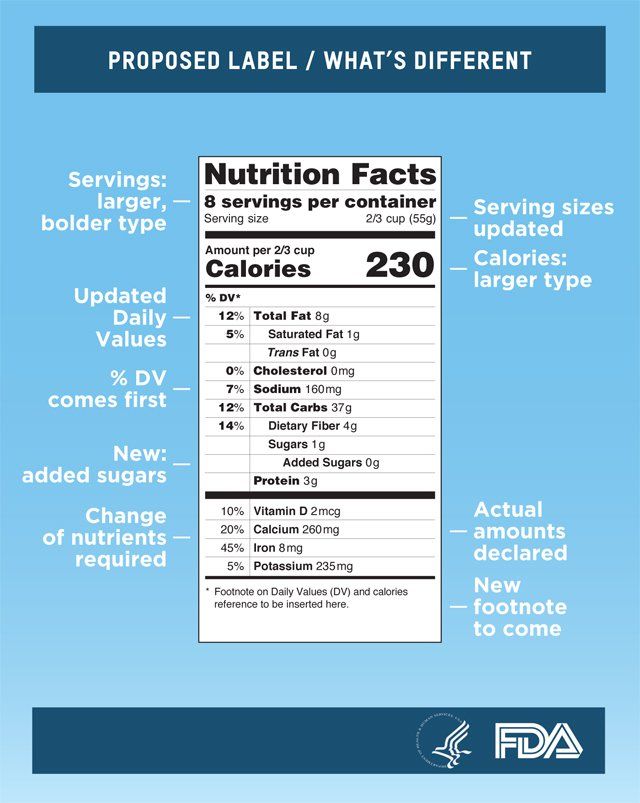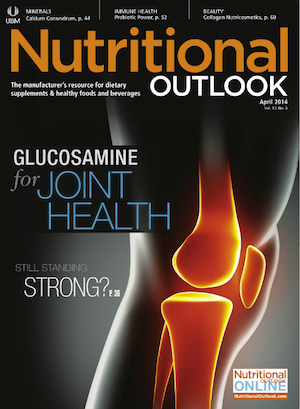FDA Wants to Update the Nutrition Facts Label
What about the Supplement Facts label?
Image courtesy of FDA

FDA wants to update the Nutrition Facts label that appears on most food and beverage packages in the United States. The most notable changes include a new way to list serving sizes, listing of added sugars, new inclusion of vitamin D and potassium content, and now-voluntary-and not mandatory-inclusion of vitamin A and C content. Manufacturers would have up to two years to comply with the proposed label once it is finalized.
Dietary supplement manufacturers-heads up! Dietary supplements may also see changes down the line. The agency says it is also looking to update the Supplement Facts label, including altered Daily Values and units of measure.
"The proposed changes will affect dietary supplement products as well. The changes to the Daily Values of certain nutrients will apply to products labeled as dietary supplements," says Justin Prochnow, an attorney and shareholder at Greenberg Traurig LLC (Denver). "The proposed rule modifies the labeling provisions contained in 21 CFR 101.36 regarding dietary supplements, although the changes to Supplement Facts panels will not be as dramatic as those to the Nutrition Facts panels."
Among the Nutrition Facts label changes proposed:
- Serving sizes have changed in the past 20 years since FDA first introduced the Nutrition Facts label-that is, Americans are eating more in a single serving. To more accurately reflect the actual size of today’s serving size, FDA has proposed changing one serving to represent 400 calories (not the current 200-calorie serving size). And one pint of food will now equal two servings instead of four servings. “By law, the label information on serving sizes must be based on what people actually eat, not on what they ‘should’ be eating,” says FDA.
- Package size matters: Because consumers will typically finish a 12-oz or a 20-oz beverage in one sitting, FDA suggests that both of these beverage sizes be listed as one serving. The Nutrition Facts label would declare the nutrition info for the entire bottle’s contents and represent one-not multiple-servings. The same goes for food: a packaged food that is likely to be consumed entirely in one sitting would be subject to the same rule. Larger packages whose contents could be consumed in multiple sittings may be required to include two nutrition panels-one that reflects what’s consumed if the entire product is eaten in a single sitting, and another that reflects the contents of just a single serving.
- Added sugars: The proposed label now quantifies the amount of added sugar. FDA says this is important in order to encourage Americans to reduce excessive sugar intake.
- Vitamin D and potassium listings now included on the label. FDA says many Americans are vitamin D and potassium deficient.
- Listing vitamin A and C content is now voluntary, not mandatory. FDA says these nutrient deficiencies are now uncommon.
- Calcium and iron listings are still required.
- Daily values would also be updated, including for sodium, dietary fiber, and vitamin D. This plays a role in the Percent Daily Values listed on the Nutrition Facts label that help consumers understand what percentage a food's contents contribute to the daily recommended total for specific nutrients.
- The actual mineral and vitamin amounts would now be disclosed-spelled out in numbers-instead of just being listed as a vague, Percent Daily Value.
- Fat: “Calories from Fat” is now excluded because FDA says research shows that the type of fat consumed is more important than the amount. “Total Fat,” “Saturated Fat,” and “Trans Fat” are still included.
- More-prominent calorie listing: Facts such as calories and serving sizes would appear in a larger, bolder font. The Daily Percent Value numbers would now appear on the left-hand side for easier reading.
If there’s something you don’t agree with, FDA is accepting public comments for 90 days-a period that kicks off as soon as the proposed rule is published in the Federal Register, which should happen shortly.
Since it was introduced 20 years ago, the Nutrition Facts label has never been updated except to include a “Trans Fat” listing.
Foods imported to the U.S. would also be subject to any Nutrition Facts label changes.
The Council for Responsible Nutrition (CRN; Washington, DC) says it is pleased to see FDA will continue using the Recommended Dietary Allowance (RDA) to establish the Daily Values reflected on the Nutrition Facts Label. Alternatively, FDA could have gone with Estimated Average Requirements (EAR), which are used to calculate the RDA. While RDA represents the daily dietary intake of a nutrient that sufficiently meets the needs of 97.5% of healthy people, EAR sets a lower bar and represents the nutrition needs of only 50% of people. As such, the RDA is typically 20% higher than EAR. If FDA had gone with the EAR, essentially it would have lowered the nutrient requirement bar.
“CRN applauds FDA for keeping the RDA as its standard for [Daily Values] on food labels. At a time when we know of significant nutrient shortfalls in the typical American diet, it would have been a mistake to water down nutritional requirements so that at most only half the population would be covered,” said Andrea Wong, Ph.D., vice president, scientific and regulatory affairs, CRN.
The association also praised FDA for planning to revise Daily Values for certain nutrients such as calcium and vitamin D to take into account updated science.
Jennifer Grebow
Editor-in-Chief
Nutritional Outlook magazine
jennifer.grebow@ubm.com
Photos:
1) One version of the newly proposed Nutrition Facts label
2) Another proposed version
3) A side-by-side comparison of the current Nutrition Facts label and the newly proposed label

Prinova acquires Aplinova to further increase its footprint in Latin America
April 7th 2025Prinova has recently announced the acquisition of Brazilian ingredients distributor Aplinova, which is a provider of specialty ingredients for a range of market segments that include food, beverage, supplements, and personal care.





















